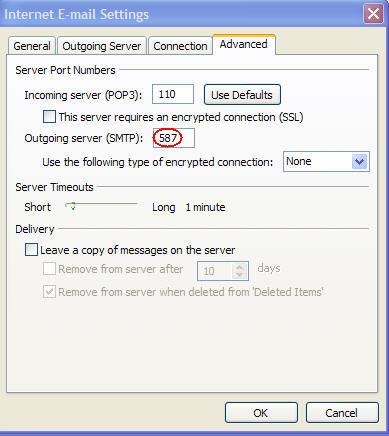Users all over the country are finding out daily that suddenly, for no apparent reason at all, they are unable to send mail if they want people to reply to their business or personal e-mail addressed other than one that is @comcast.net. This is because Comcast is blocking port 25 , which is your default port for sending email through your mail software.
The error message says (fill in your own X):
The connection to the server has failed. Account: ‘XXXX’, Server: ‘xxx.xxx.xxx.xx’, Protocol: SMTP, Port: 25, Secure(SSL): No, Socket Error: 10060, Error Number: 0×800CCC0E
Gee that’s helpful, isn’t it?
If you are using mail.yourdomain.com for your SMTP outgoing mail server, then you get an error saying “unable to connect to the mail server” even though it just successfully connected to the mail server to retrieve your incoming mail. After wasting time calling your web host, and going through various troubleshooting techniques, they tell you to call Comcast.
To make matters worse, users are finding out one at a time, because Comcast is slowly rolling out these changes user by user in individual markets around the country. This month, it’s apparently Portland Oregon’s turn, where I live.
To cut to the chase, here’s the solution:
Change the port your computer is using for SMTP outgoing mail, from Port 25 to one that your hosting provider will allow. In most cases, this seems to be port 587 for Portland providers.

To do this in Outlook -
- Go to tools – e-mail accounts – view or change existing account
- Sselect the appropriate mail account and hit the change button
- Go to the more settings button, and into the Advanced tab
- Change your default port 25, to port 587, and you should be back in business in most cases.
Still broken?
- Added note from comments below – Some people in the midwest for whom 487 didn’t work succesfully chaged to 465 and picked SSL under the “use the following type of encrypted connection” drop down. They did not check the “this server requires an encrypted connection” box.
In Outlook express -
- Go to tools – accounts – Mail tab
- Choose Properties box – Advanced Tab – and from there you can do the same
The reason Comcast claims to be doing this is in an effort to prevent spam being sent by zombie/spyware/virus laden computers using their bandwidth and their Internet connection.
I suspect they are really doing it to limit liability for any future potential lawsuits, and not really to save bandwidth, but I have no problem with that.
The problem with Comcast doing this is that they do not seem to be telling all of their support people, and do not be notifying their customers. This has been going on around the country for MONTHS.